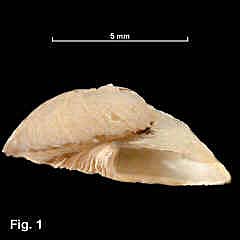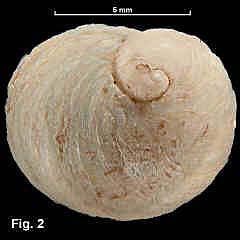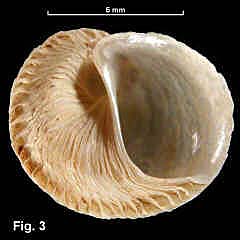|
|
|
|
|
Naricava angasi (A. Adams, 1863) Description: Spire low, spire whorls rounded, body whorl sharply angled at base.. Protoconch of 1½ whorls, with three weak spiral cords, ending abruptly. Teleoconch with dense axial lamellae on first 1 ½ whorls, fading away to growth lines. Spiral sculpture absent. Base with flange at periphery, formed from lamellae that cross the base and continue into umbilicus. Umbilicus widely open. Aperture wide; outer lip semicircular, smooth; inner lip of aperture smooth. Colour white. Size: Up to 6 mm high, 8 mm wide. Distribution: Endemic to Australia; Moreton Bay, Queensland, southwards to Port Fairy, Victoria, and Tasmania. Habitat: Known only from dead shells from beach washup and down to 157 m. Uncommon. Comparison: N. angasi is a very flattened shell, with the last whorl rounded on top but sharply angled at the base. N. angulata has the whorls sharply angled at top and bottom. N. vincentiana has the last whorl rounded. Both N. angasi and N. vincentiana has a spirally corded protoconch, but the sculpture is much stronger and more consistent in N. vincentiana. N. kimberi has a peripheral keel on the base like N. angasi, but lacks the base lamellae. Remarks: There may be several species involved here, as there is variation in the strength of the protoconch sculpture. Fig. 1: 4009-1 Off Tuggerah Lake, NSW, in 60 m (C.211333) Fig. 2: 4007-1 Same specimen as Fig. 1 Fig. 3: 4008-1 Same specimen as Fig. 1 |


